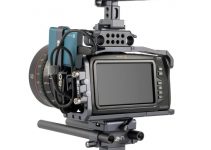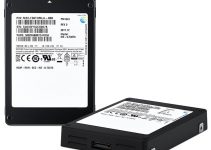Last year has seen the announcement of an unexpected camera, the second iteration of the Blackmagic URSA Mini Pro, the so-called G2. With it, Blackmagic Design hit the mark of the seventh year in the business of camera making. That’s not to say they were not around before that.
The name was well known to broadcasters and such. So, the comparison here is a particular one. JSFILMZ has thought of getting the G2 side-by-side with the RED Dragon Scarlet, the camera that RED produced at their seventh year in the biz. So, let’s take a look at this “back to the future” comparison.
The idea of this challenge is a fun one and there are obviously some things to consider: the RED Scarlet came indeed after seven years from the original RED ONE, but it has been a good four years earlier than the G2, and tech goes a long way in four years, not to be forgotten is the price tag of the cameras.
These two rivals come from two very different realms. On paper, the Scarlet has a couple of stops more in dynamic range, topping at 16,5 against the 14 that Blackmagic claims. Looking at the footage side by side we can say that that’s the case indeed, the Scarlet has a little bit more of data in the highlights, and surely outperforms the G2 as for indoor or lowlight shooting. In outdoor daylight situations the URSA Mini G2 shines, its color science is almost Alexa-like.
Gone are the days when you had to invest almost half of the budget for an editing station with a Red Rocket-X, the almost 7K card you need to be able to encode and decode REDCODE RAW footage on your NLE of choice. The computational power of the latest generation of CPUs and GPUs added to the speed of new SSDs makes it much easier to edit the humungous files RED cameras can produce, but still, REDCODE RAW is not a very edit-friendly codec.
The unveiling of BRAW, on the other hand, was a huge novelty in the scenario of CPU heavy codecs like H265 and such. BRAW takes off much of the load from the computer and the results are tangible. Both the contenders should be called cinema cameras, and that implies that they are made to be used on set, an environment where a DP sheds light to make the scene look good. This detail is often overlooked when considering the low light performances of conventional cinema cameras against mirrorless ones like Sony’s A7 series.
These offerings instead are meant to work in a range of ISO that usually does not top the 3200 mark. Comparing the two screenshots below, it’s fair to say that the G2 has a slight edge. Although the Scarlet has more dynamic range, the detail in the shadows is better on the Blackmagic’s camera.
Brain alone, the Scarlet is a nice paperweight. It is indeed in the nature of a cinema camera to be like that, customizable and able to adapt to every scenario, but at the same time, the base package is almost useless. If we were to try to compare, the ergonomics of the Scarlet are way different than the G2, but at the end of the day, it’s a matter of design, the G2 is meant to be a camera on its own, the Scarlet is not.
The G2 gets also the round on codecs thanks to the multiple formats and ratios you can use as opposed to the RED where you’ve got pretty much REDCODE RAW. What about where to store the media you are shooting? In the case of the URSA Mini, users have the ability to record onto common SSDs right out of the box through a USB-C port.
The price comparison with RED’s mags, even the first generation, is simply not possible. So the G2 collects another victory alongside with the superior recording formats. In fact, thanks to the upgraded internals, the camera is capable of shooting up to 120fps at a whopping 4.6K resolution whereas the Scarlet maximum frame rate at 5K is 50fps.
This comparison seems to go all in favor of the G2, but there are indeed a lot of arrows in its quiver. Once you press the button to turn on the camera you’ve got a mere 10 seconds before being able to shoot. The Scarlet, on the other hand, requires somewhere in the neighborhood of 30 seconds.
This spread between the two becomes even larger if you consider the calibration time. As for that, we’re talking of 1-2 minutes for the G2 and almost 5 minutes for the Scarlet.
The G2 keeps scoring, this time with one of the most renowned features common to all Blackmagic cameras, and that’s the menu. As we said times and times again, no camera manufacturer (besides ARRI, of course) has got even close to the ease of use of that menu system.
RED’s menus are so intricate and complex that it’s easy to get lost. There are even apps to get yourself more comfortable around it. It would be inconceivable to make an app like that for the G2.
It would seem that the URSA Mini is crushing the Scarlet, even on the audio front and rolling shutter we have again a clear winner in Blackmagic’s camera. The Scarlet gets back on top only when we get to video connections.
The presence of both HDMI and SDI goes in favor of RED, whereas the G2 has only SDI connections that are indeed a professional standard but are cumbersome and it’s always better to have a choice.
Going to the conclusion the ending seems obvious. Even without factoring the price, the G2 is a better choice. Once you take into account the huge price difference, there is no match.
These two cameras are aimed at two completely different markets. For an independent filmmaker, though, it’s just much more convenient to invest in a Blackmagic camera. Things get wildly different if instead we’re talking of big production studios and such. But that’s a different story.
[source: JSFILMZ]
B&H Order Links:
SCARLET-W BRAIN with DRAGON 5K Sensor
Blackmagic Design URSA Mini Pro 4.6K G2
Disclaimer: As an Amazon Associate partner and participant in B&H and Adorama Affiliate programmes, we earn a small comission from each purchase made through the affiliate links listed above at no additional cost to you.



